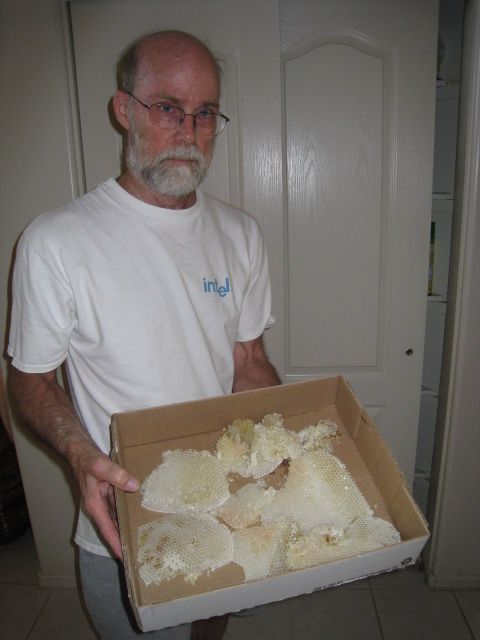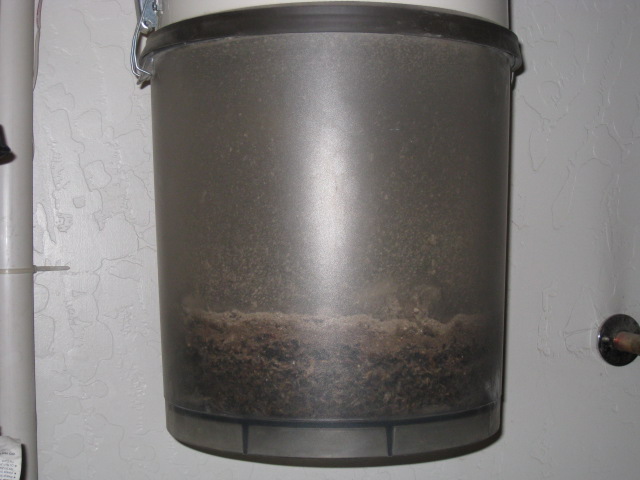After 4 days of vacuuming up bees, I decided it was time to get serious.
I went to Lowe’s and bought a can of “Wasp and Hornet Spray”. They can’t advertise that it kills bees because they are protected, but they assured me it would work fine.
I found the most likely place for a hive — it’s a box-like extension to the wall where the dryer hose goes out. I drilled a 3/8″ hole through the drywall, stuck the spray nozzle in the hole, and sprayed for a few seconds. Then I quickly covered the hole with duct tape.
In a few seconds a gentle buzz turned into a loud hum that grew until it was a frightening roar. Thousands of bees must have been beating their wings, trying to find an enemy to attack. The vacuum cleaner was sucking at the outside entrance, and could barely keep up with the swarm as they flew outside. Many of them got past, and we could see them swarming around the porch light.
I sprayed poison into a few other nearby locations, and got more reactions in a couple of them. But it was clear that the first shot had been on target.
It took almost an hour before the roar died into a faint humming sound, and we went to bed.
This morning I sprayed a little more in, just testing if there were any live bees, but there was no reaction. So I cut a hole through the drywall into the box. Here’s what I saw through the hole:

I had reached in and broken a small piece of the honeycomb off before I took the picture, but most of it is intact here. The two bees on the comb are dead. Look carefully in the bottom and you can see lots more dead bees — about 2 inches thick. There were even a few larvae, though they’re hard to see in this picture.
Here’s what it looked like after I got it all out:

That’s a lot of comb to have been created in the few days they have been there, especially since I have been continually decimating their workers. I guess they had been as busy as bees.
And here’s a close-up:

There’s honey in that comb, but not a lot. I was sucking up most of the bees before they had a chance to get back in the hive, so they didn’t deliver much nectar. Even this wasn’t edible, because it was soaked with insecticide.
Finally, here’s a picture of the vacuum cleaner with dead bees.

The canister is 12 inches diameter, and the bees are 3 inches deep (with a little drywall dust on top of that where I cleaned up after cutting the hole). That’s about 340 cubic inches of bees. Assuming a 10 x 10 x 10 cube of 1000 bees is about 4 inches on a side, or 64 cubic inches, there must be around 1000*340/64 or over 5,000 bees. And that’s probably a low estimate.
Things are quiet in my house again. I feel a little bad about killing off so many bees, but I didn’t want to take any chances. The bee man who came on the previous call said that he doesn’t try to save the bees any more, so they would have died anyway. I guess the local beekeepers have plenty.

4 responses so far ↓
1 Donna // May 12, 2009 at 5:54 pm
Oh my! I don’t have words. I guess… incredible, amazing, gross, poor things, yum!, ewww, and WOW. No wonder you were seeing so many outside.
Sounds like you have a new vocation. If you want one. : )
2 Heather // May 12, 2009 at 9:19 pm
That was very clever and brave. Probably saved quite a bit of money too!
3 Don // May 12, 2009 at 11:33 pm
That looks very similar to the amount of honeycomb my bees made and they were only there for about 2 weeks before my bee man took them. I got to taste the honey in mine but you certainly wouldn’t want to try it after the insecticide.
Hopefully we won’t see any more at either of our houses.
Just a reminder I got lots of pictures of my bees getting put into their new hive if anyone hasn’t seen them yet. They are in my Gallery.
4 Les Landrum // May 13, 2009 at 9:24 am
Congratulations on a successful extermination. Strange how we feel kindly towards some insects and not others. We think of bees being our friends along with butterflies. Roaches are not. We have some beautiful butterflies that eat our passion flower vine down to stems (when they are still larvae and ugly). We like the adults but not the larvae.